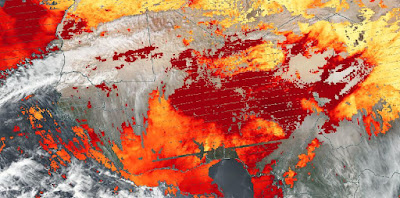 |
| Caption: Satellite images of dust loading (Red) across West Africa afternoon Jan 3, 2020 |
 |
| PM concentrations and Air Quality along with mortality risk |
Since January 1, high Particulate Matter ( dust concentrations) have occurred across West Africa. Senegal and Cabo Verde have seen the heaviest reported values in the north. Some of the airports in Cabo Verde closed because of low visibility. However, in the south, Ghana, Ivory Coast, Nigeria, Togo, Benin, have experiences high PM values since Christmas. I am 100% sure that there have been morbidity and mortality in these locations in the past.
What is different now is that we are using cost-effective sensors to get a look at what is happening across West Africa in real-time. This allows us to link the environment to health outcomes. We have been developing a network (measurements) in Senegal, Gambia, Cabo Verde, Ivory Coast while others have been developing low-cost networks in Ghana, and Togo. Together we get a sense of the air quality from good to hazardous, where the real-time colors correspond to air quality on the maps.
https://www.purpleair.com/map?opt=1/mAQI/a10/cC0#4.15/12.99/-22.89
 |
| US EPA Air Quality Standards for PM2.5 and PM10 |
 |
| Purple Air estimates of Air Quality for the morning of 3 January 2020 |
What is driving force behind the current set of dust events? There are large sources of dust over Northern Africa. Two of the biggest dust sources are Bodele (the largest in the World) located in Chad, and the Adrar region of Southern Algeria and northeast Mali. The Azores high-pressure system which exists over the subtropical ocean and is part of the North Atlantic Oscillation (NAO).
During the winter, the Azores high moves into North Africa across the Sahara and while high pressure normally means sunny weather, over North Africa it also brings strong winds over the desert which then starts the sandblasting process.
 |
| Depiction of how the Azores high to drive a dust storm |
What is happening now, is that high pressure is currently in place for all of North Africa. The figure from GFS forecast strong high pressure in play.
 |
| GFS sea level pressure and anomalies across Africa 0000 UTC |
This means winds will flow across Chad and drive westward flowing winds that send dust from East to West. The dust will flow into Nigeria and lead to poor air quality over the next few days to week.
 |
| January 4, 2020 Visible and AOD position of dust. Circled in red are Adrar and Bodele dust regions |
So what are the proper actions to take if you suspect or see that the air quality is poor (unhealthy to hazardous)?
1.) If air quality is poor, limit your time outdoors and your physical activity.
2.) Wear a mask if you have one until conditions get better. This may not seem cute, but you are not sick!! You are trying not to get sick.
3.) Pay attention to the elderly, and young children.
4.) If breathing problem begin or you feel chest pain go to the Emergency Room to be checked
by a doctor.
Other Sources of Poor Air Quality
On the continent, there are multiple sources of pollution that can make air quality poor. In rural areas, seasonal biomass burning which is tied to agricultural practices can create very poor quality. Large megacities are now becoming problematic because of traffic, waste, and industry. The waste that is being generated is burned in large waste sites or locally leading poor air quality. Traffic has become worse with no end in sight. Many of the cars use low-quality diesel fuel with high sulfur content making pollution horrible in places like Dakar, Senegal. The so-called modernization of Africa is leading to pollution-causing industries, like cement and coal-burning power plants.
 |
| Sources of pollution including Traffic, Industrial pollution and burning of trash |
Finally, there is indoor pollution from cooking. We know this is bad for family members who use biomass or charcoal, especially in poorly ventilated buildings.
We need to predict, communicate and protect individuals from air pollution for success. Ultimately, government policy is required to address pollution issues. Everyone who has a friend or family member has something to gain from improving air quality.




No comments:
Post a Comment